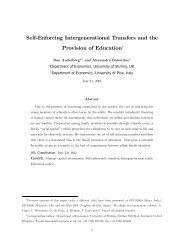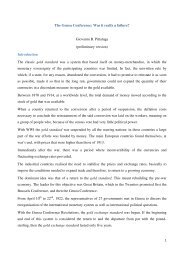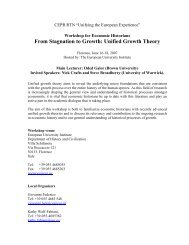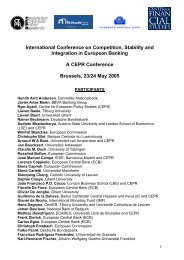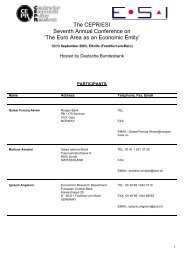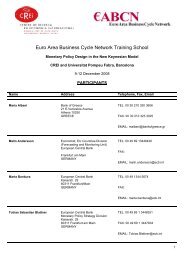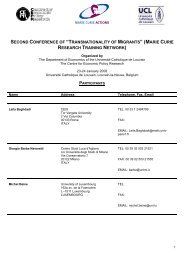MARKET STRUCTURE AND ENTRY: WHERE'S THE BEEF? - CEPR
MARKET STRUCTURE AND ENTRY: WHERE'S THE BEEF? - CEPR
MARKET STRUCTURE AND ENTRY: WHERE'S THE BEEF? - CEPR
Create successful ePaper yourself
Turn your PDF publications into a flip-book with our unique Google optimized e-Paper software.
+θiS3OWNNBjt+θiS4RIVALNBjt +s(mijt,θSi)+ρi ηj.<br />
In (6), OWN and RIVAL are the numbers of existing outlets in the district ρi determines<br />
the variance share of the random effect, ηj is the market-specific time-invariant error<br />
term, and βi, θSi and ρi are firm specific (vectors of) parameters to be estimated. In<br />
standard fashion, we assume that ηj is i.i.d. normally distributed with zero mean, that<br />
2<br />
cov(ηj,εijt)=0, and that σ ≡ 1.<br />
ε<br />
Population is likely the leading determinant of market size, but because different<br />
age groups may display different tastes for eating hamburgers, we add age group controls<br />
into S(.). We include own and rival outlets in neighboring markets in S(.) since if tastes<br />
are correlated among neighboring markets, firms may use information they learn in<br />
adjacent markets to update their predictions of market size in a particular market. The<br />
coefficient of POPulation in S(.) is normalized to one following BR. The coefficients of<br />
the S(.) variables can then be interpreted as increases or decreases in expected market<br />
size, measured in population equivalents.<br />
We specify variable profits per customer as<br />
(7) Vijt(.) = γi1AREAjt+γi2WAGEjt+θiV1OWNjt+θiV2RIVALjt+θiV3OWNjt*RIVALjt<br />
+θiV4OWNNBjt +θiV5RIVALNBjt.<br />
In (7), γi and θVi are firm specific parameter vectors to be estimated. Incorporating<br />
the set of neighborhood variables into V(.) has two motivations. First, the number of own<br />
outlets in adjacent markets allows a control for possible economies of scale in<br />
distribution. The firms have some regional facilities that may serve several of our<br />
markets. If these operations are characterized by economies of scale, we would expect<br />
θiV4 to obtain a positive value. Insofar as the rival’s operations have this characteristic,<br />
21



